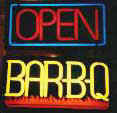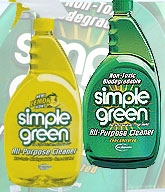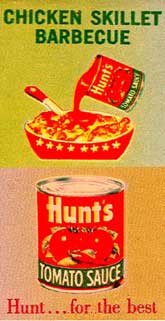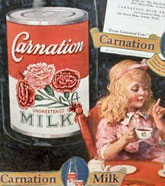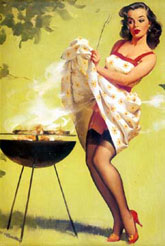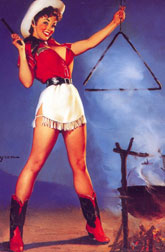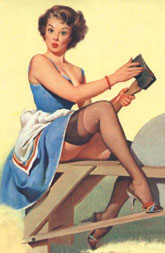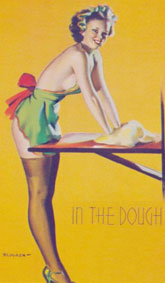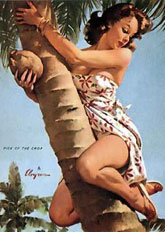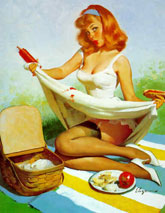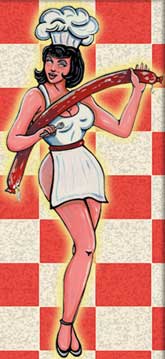Contact BBQbyDan
www.BBQDan.com
Search
KCBS BBQ Cook-Off Info
Recipes,
Smoking Meats
Recipes, Grilling
|
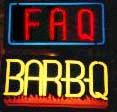 |
FAQ OF THE INTERNET BBQ LIST Version 2.0 Section 17 Problems While Barbecuing--What Went Wrong? |
17. Problems while barbecuing--What went wrong?
--------------------
[I tried to smoke a 3 lb. sirloin tip roast yesterday. Held 220F as best I could (you know how that is). Had rubbed it with pepper and garlic after oiling the outside, hit it with oil once more and sprayed it with water every hour or so. Was on for nearly 6 hours and the internal temperature never exceeded 138F It was rather dry inside.]
Ed Pawlowski--
My guess is that while you were waiting for the temperature to go up, the roast was just drying out. I've done sirloin tip, but for less time and it was good. Could be that it was just a dry tough piece of meat anyway.
--------------------
[I'm new at barbecuing. I finally broke down and bought me a New Braunfels smoker. The problem is the meat turned very black and was bitter (especially the briskets). I expected some blackening of the meat due to the smoke but the briskets were so bitter my dogs laughed at me. Any help would be appreciated.]
Ed Pawlowski--
The bitter and dark smoke you encountered was from having too big a fire dampened down too low. You want a small amount of fuel burning to make the temperature you need. Smoldering wood will produce heavy smoke and give the meat a bitter taste. Open the dampers and control the temperature by the amount of fuel. If it gets too hot, instead of closing the damper, open the cooking chamber door to release the heat. Most of all, practice. You will get better each time.
==============Tom Kelly--
First piece of advice from a Q-newbie like me would be ignore the NB instructions to use the exhaust damper. The group says, and I follow their advice, to leave the exhaust damper wide open. Otherwise, you can get incomplete combustion and the bitter creosote flavor.
==============Belly--
Rule 1----small fire, open inlet damper
Rule 2----big fire--- you get burned, bad-tasting meat
Rule 3----small fire, six pack, good meat, ten hours slow cooking
==============Rodney Leist--
Probably one of the biggest hazards to great tasting barbecue is stale smoke. The reason for including a few words about this subject here is because bad wood is often blamed for bitter tasting barbecue. More often than not, the real culprit is smoke that has been trapped in the meat chamber and allowed to cool and condense on the meat (creosote). ALWAYS leave the exhaust vent completely open to prevent smoke from becoming trapped and cooled in the meat chamber. Use the inlet vent to control the fire. Trapped smoke picks up bitter flavors from creosote buildup in the chamber, cools, and deposits them on the meat, just like a rain cloud. Stale smoke can also be caused by the fire cooling too much due to lack of attention or attempting to add too much cold wood into the fire chamber. No matter what the cause of stale smoke, the meat comes out the loser.
==============Editor--
The ideal situation in a wood-burning smoker is for the fire to have all the oxygen (air) it needs for complete combustion of the wood. This gives the cleanest-burning fire and the cleanest, best-tasting smoke. So keep that fire no bigger than necessary, the exhaust damper wide open and that inlet air damper mostly open.
--------------------[I purchased a Brinkmann charcoal water smoker last year. I'm having some problems with temperature control. The temperature drops as the hours go by even though I have the same size fire. Any ideas on this?]
Scott Mark--
When you light a big pot of charcoal, with the smoker top portion off, there's plenty of oxygen available. All the coals get burning; all the coals get hot; all the coals give off a lot of heat. [Editor--the same applies when you start a fire in a bullet water smoker where the fire pan section cannot be removed from the smoker section.]
When the smoker top gets put in place (or the fire door closed), the air flow gets cut back quite a bit. The coals slow their burning rate, and they don't generate as much heat. The overall amount of heat being transferred into the smoke chamber is less. As the charcoal burns, ash accumulates, further reducing airflow. The only solution I've found that works well is to lift the entire smoker off of the firepit (my smoker is actually three parts: fire pit, cylinder, and dome top) and then use a shovel to dump the burning charcoal on top of a grate (getting rid of ash, which is also removed from the firepit) and then reloading the firepit with the burning charcoal and more that is already burning. Because of the lack of airflow, adding non-burning charcoal to the pit doesn't do much good.
==============Editor--See Section 7.2.1 for modifying this type of smoker. In most bullet water smokers you cannot remove the smoking chamber from the firepit chamber--they are fastened together. So the only way to remove the built-up ash is through the fire door. Until you make the changes that allow the smoking chamber to lift off the firepit, use a poker to get the ashes out of the firepit pan. Be careful if you have the smoker on a wooden deck as the hot ashes and bits of burning charcoal may set the deck on fire.
--------------------[I smoked a brisket. It tasted great but had the texture of old tires. It was still juicy but was very gristly and sinewy. Did I overcook it?]
Rick Thead--
It was undercooked. Brisket is just about the nastiest piece of meat out there. It really has to be cooked past the point of 'doneness' to be edible. But, IMHO, when cooked properly, it's the best barbecue there is.
If you are having trouble keeping the temperature on the smoker up, then smoke it as long as you can for flavor, then wrap it in heavy duty foil and finish it in a 250 to 275F oven. I'm not recommending this as a preferred method, but in some cases, it's the only way to go.
Here's how to tell if a brisket is ready: check it by feel. I happen to use one of those small instant-read thermometers to track how the meat is doing. I found that I can tell by the feel when I insert it in the meat if the meat is 'done.' You could also use a carving fork, but try not to poke any more holes in the meat than necessary. When you can feel that the thermometer glides in without any resistance, it's done. If you feel any resistance (it feels like it's hitting gristly meat), it's not ready yet. If you've ever cooked corned beef (usually brisket) the principle's the same. Anyway, if you check the meat periodically, you'll be able to detect the shrinkage of the tough part. Shoot for about 160F internal temperature.
-------------------[I smoked a fatter than normal Boston butt and long before it should have been done, it was up to 190F internal. What went wrong? I took it off so it wouldn't get tough from too much cooking.]
Danny Gaulden--
The first reason that the butt cooked faster than normal is because it was 'fatter than normal'. Smoked at the same temperature, a fat butt, brisket, spare rib, etc. will cook a lot faster than a leaner cut. Guaranteed. Second reason would be that you might have smoked it a little too hot. No big deal. In a bind, I've smoked butts at 300F+ and they turned out very, very good. Don't worry about it "getting tough" after you have cooked it to the tender state. It's not going to get tough, it will get dry.
--------------------[Is it possible to over-smoke something? The last time we smoked some meat, it had a very harsh, acrid taste that was not appealing. Simply put, it was sour!]
Larry Willrath--
Sounds like you might have gotten hold of some green wood or your smoker is very dirty. I would check the type and age of the wood and the condition of your smoker. I use some green wood but try to limit it to a 1-hour burn or not to exceed 15% of the total smoke cycle. This acrid taste could also be caused by an oxygen-starved fire--creosote on the meat.
==============Frank Boyer--
I once cooked a large quantity of ribs and left 10 to 20 slabs sitting in the cooker after I served. The slabs pulled out when they were done were good, but the ones that sat in the cooker after I stopped putting wood in had a very bitter taste. What I am guessing happened is that after the fire died down the smoldering wood imparted the bitter taste on the slabs. So what might have made the difference on your "over-smoked meat" was that the fire died down, started smoldering and caused the bitter taste. I have cooked brisket up to 16 hours and whole hog for 25 hours and never had a bitter taste problem. Some people say preburning the wood will eliminate the bitter taste.
==============Editor--
If you are going to leave barbecue in the smoker to keep warm after you have finished smoking it, always wrap it in aluminum foil to prevent what happened to Frank's ribs.
==============Mike Cain--
I've run into situations of using green or wet wood--beware of molds or other natural fungi that can grow on the bark of these pieces. There are some pretty scary-looking and smelly grungies that can accumulate on certain pieces of wood which could affect the flavor of the smoke, especially at lower temperatures. Pre-burning will eliminate most of these problems.
-------------------[How can I keep the doors on my Oklahoma Joe's smoker from leaking smoke?]
LannyH--
One way to keep smoke from leaking out your doors is to increase your smokestack height. This will create a better draft (negative pressures) in the chamber. Use gutter down pipe to test with because it is cheep and easy to work with. Start with 4 ft. and keep trimming it off till you get it balanced. Draft can be used as an engine to force air and create eddies and turbulence in the cooking chamber which will distribute the heat more evenly. Reduce the size of the opening from the fire box to increase the velocity of the smoke. Too much draft can suck in too much cold air into your cooking chamber if it has too many leaks.
--------------------[I smoke-cooked a brisket the other day and it was too dry. I followed all the directions from the List. What went wrong?]
Danny Gaulden--
Frank cooks his pork butt to 185F internal temperature and it turns out very tender, moist, and just great. John cooks his butt to the same internal temperature and it is dry, overcooked and unacceptable. This can happen not only with pork, but with brisket, chicken, and other cuts of meat. What went wrong? This is a degree of smoking that, to my knowledge, has not been addressed. Here's the real deal.
The temperature at which you are smoking the meat is a great determining factor as to "when to take the meat off at x temperature." If Frank smoked his pork butt at around 240 to 250F, or even a little higher here and there, the 185F internal temperature will work great. If John smoked his butt at 210 to 225F and brought the internal temperature up to the same as Frank's (185F), his meat will be dry, over cooked, and just a bad experience.
Here's what's going on inside the meat. Since the meat itself works as an insulator in its own right, and if you are cooking at just a few degrees above the internal temperature you are wanting to achieve, chances are that it will never achieve it, and if it does reach your target temperature, the meat will be overcooked. The wider the gap between the cooking temperature (to a point) and the internal temperature one is wanting to achieve, the easier it is to get there. Go by guidelines some of us set as "taking off temperatures".
If one is smoking at a lower temperature than the recipe calls for, then adjustments must be made to the "take off the fire" internal temperature of the meat. For instance, John should have taken his pork butt off the fire at a much lower internal temperature than Frank did. I would guess at about 170F or so, but I'm not for sure on this since I don't cook at the 210-220F range. The reasons for this are simple. If the meat is cooked at a lower temperature, it will take a longer time to get tender (break down the collagen). When cooking at a higher temperature, the meat collagen will break down at a faster rate due to the higher temperature. How far one can go on either end of this style of cooking technique will be argued until the end of time.
So here's where I'm going with this post. This applies to meats that need to be smoked long and slow--the tough cuts of meat. This does not apply to tender meats that can be cooked at higher temperatures for short, fast cookings, like pork loins, whole rib eyes, etc. If you are following a recipe that calls for an internal temperature of say 180F or so, make sure the temperature in your smoker is a least 60 or 70F above that target temperature. For example, to get to a 180F internal temperature, I would cook in the 240 to 250F range. If you are cooking at a lower temperature, then make adjustments downward for the internal target temperature of the meat. You would take the meat off at a lower internal temperature, but it would cook longer.
Tip: On the longer, slower smoking meats, add one hour more cooking time for every 10 degrees F that you are staying below the ideal cooking temperature. For instance, if I said smoke a 10 lb. brisket for 10 hours at 240F, and you are cooking at 220F, you would need to cook your brisket for approximately 12 hours. You can take that to the bank.
After so many years of barbecuing, I take my meat off by the fork-tender method, and am sure that a lot of you ol' backyard pros, and professionals do also. But I sure didn't when I first started out! Felt like this is a letter that needed to be written for the many beginners and intermediate level guys and gals out there.
-----------------[I recently purchased NBBD smoker. I keep running into the same problem when I try to smoke briskets and ribs. There is too much smoke. The ribs have a smoke ring all the way through them, and the brisket is way too smoky. When I cook the ribs, I use a lot of regular charcoal, and only one 12" piece of hickory. What do you suggest?]
Stephen J. O'Connor--
I had the same problem with my OK Joe of a similar design. I was burning straight wood, though. The problem with these units is the temptation to build a fire big enough that you don't need to tend it so much. I kept having to choke my fire down after getting it going. I made the mistake of trying to control my fire with the exhaust vent, rather than the intake. This resulted in stagnant smoke and a sooty flavor. Be moderate with your fire, even though it will mean more tending. Regulate from the intake rather than the exhaust, even though it is slower to respond. Lastly, give up charcoal briquettes and get lump charcoal--it gives a much cleaner flavor.
==============Frank Boyer--
Try using 2-3" chunks of flavor wood. Hickory is one of the strongest woods--pecan is mellower. Make sure that you have a good air flow through the smoker. Don't control the outlet airflow--i.e. keep that exhaust vent wide open. If the smoke smells nasty the meat will taste nasty.
--------------------[My first attempt at smoking a brisket in my NBBD was nothing to write home about. I started with lump charcoal and then moved to wood for a total of about 14 hours at 200-220F as best I could hold it. I took the brisket straight out of the smoker and into the freezer. Pulled it out today and popped it into a 250F oven, foiled, for about 3 hours. It is smoky, no doubt about it. The Mr. Brown is a bit bitter so I cut most of that off. The meat is VERY tender but a little dry. It tasted much like a mild pot roast with little flavor other than smoke. I did marinade it overnight in a concoction of beer, Dr. Pepper, and various spices. It was 8 pounds. Any help?]
Danny Gaulden--
Here's why your brisket was not up to expectations:
1 You should have kept your smoking temperature between 240-250F. You smoked at too low a temperature.
2 Total time shouldn't have been over 10 hours for an 8 pound brisket.
3 One reason it was too smoky is because you smoked it too long and too slow. With a little hotter fire, your smoke density would have been considerably less and your smoking time shortened. Using lump is a good way to decrease the smoke also, as well as preburning your wood.
4 The reason your brisket was "very tender but a little dry" is this: You overcooked it. A brisket is suppose to be "tender and moist", not "very tender and dry". If you smoke it to the point of being "very tender", there is a good chance it is overcooked and will also be dry.
5 The pot roast flavor came from warming your brisket in foil in the oven from the frozen state. You should have let it thaw in the refrigerator, then just warmed it up in foil to serving temperature in the oven. And I mean just warm--no more cooking.
6 Forget the marinade. Use a good rub, mop with a good mop every hour, and turn the brisket over every hour or so while barbecuing it in your smoker. Guarantee you will see a big difference in your end product.
7 I don't have to turn my meat over in the big smoker in my restaurant, as it is a carousel style. Cooking on a stationary smoker without a good baffle system, or convection tube, is another ball game. You must mop and turn and rotate the meat every two hours or so. If you don't, it will dry out on the bottom side from constant heat pounding.
-------------------[I smoked my turkey for 8 hours at 250 to 275F and used an internal thermometer in the breast and took it off when the internal got to 178F. Then I wrapped in three layers of heavy foil and a beach towel to let it cook itself. The result was that the breast was very dry. The skin was black and unusable. Did I cook it too long?]
Danny Gaulden--
I would say you cooked it too long. That is why the breast meat dried out. I have posted in the past that 6 to 8 hours was long enough for a turkey up to 20 pounds, and that was at about 225 to 240F. Even at 250F, it does great. This is where the 6 to 8 hour timing comes into play--depends on the temperature you're holding, as well as the make-up of the bird. If you were pushing 275F, 8 hours is way too long. And you certainly didn't need to wrap it in a cooking garment of triple foil and a towel to keep the cooking process going.
You should have done an oil rub all over the bird before you smoked it, as well as a few times as it was cooking. This is important for a nice tender skin and color, as well as helping keep the breast and other body parts a little more moist.
The reason it looked like a "victim of arson" is this (my opinion): The higher one keeps the temperature in a smoker, the more 'stuff' (soot, possible creosote, blackened skin, ugly looking, whatever you want to call it) one is going to get. Remember, cooking on wood is NOT the same as cooking in an oven with gas or electric heat. These types of heat have no residue--they are clean pure heat. Wood is not. You have 'stuff' to contend with. The higher you push the temperature in your smoker, the more chance for a blackened, ugly product. This is due to the fact that the hotter you want to cook, the more wood it takes, the more wood it takes, the more chance for 'stuff' to accumulate on the meat. I am fortunate enough to have a smoker that is very forgiving of this respect, if kept below about 275F. Most people aren't so lucky. However if I pre-burned my wood, I could probably cook at 400F or higher, but that is hardly practical, nor do I wish to do it.
The 225 to 250F cooking range serves many purposes. Here's why: 1) is that this is just a great temperature range to cook in for getting little residue from the wood, if done properly; 2) is that this is an ideal temperature range to smoke meats at--low enough to get good smoke penetration, and high enough to 'cook and sweat' the meat without smoking so low that it dries out the meat or getting so hot it boils out all the moisture. IMPORTANT hint here, hope you're paying attention; 3) there is a great flavor produced within this temperature range; 4) is that the shrinkage of the meat is kept to a minimum. On and on we can go.
There is no doubt in my mind that if one is using a wood-fired smoker and wants to guarantee a product with no creosote, or over-smoked flavor, the way to go is pre-burning of the wood. Most of us are not willing to go to that trouble, nor want to lose the energy the wood is giving off as it pre-burns. So what do you do, you learn how to make a fire that will not produce these bad effects. You learn where to put the logs on a fire so that they don't explode into a ball of flames over a bed of coals and cause a creosote or soot problem. You learn when to put the meat on the smoker. You learn how to set you intake damper. You learn what age the logs should be to help you achieve this goal. You learn when to shovel some of the coals over to one side, add a log, and keep cooking without causing a problem. You learn when to add a log to maintain a steady heat--not too soon, not after the fire has dropped too low. No spikes wanted here, just a good even temperature. Another important tip: only practice will help you achieve this. Also, you learn to move the meat to a different spot if your cooking zone gets too hot or cold while getting the fire back to where it should have been to start with.
-------------------[I did some ribs yesterday and although they were quite edible I would have thought that they would be more tender. --snip-- According to Danny Gaulden, the ribs should not take nearly as long as the butt but they came very close. Should I have wrapped the ribs earlier in the barbecue process or what?]
Rock McNelly--
Well, as far as your ribs not being as tender as you had expected, my guess is that they were cooked too long, at too high a temperature. Those bones really do help to cook the meat from the inside out, so it just doesn't take that long. By my calculations, your ribs cooked for 9 1/2 hours! That's way too long. Even wrapped, they will boil off their moisture in that long of a time in the smoker.
Most ribs can be cooked to perfection at 240-250F in 4 1/2 hours. Every once in a while you'll get an ornery pig that's a bit more tough than the average pig, and may go as long as 5 hours. But it's rare. Anything after 5 hours is just asking for rubber. If you can do it, place the ribs on a rack under the butts so that the juices from the butts will baste your ribs--keeps them moist. If not, use Danny Gaulden's mopping method to keep the ribs moist.
--------------------[I tried my second all-wood run in my NBBD and the finished ribs were very bitter. There was a lot of dense white smoke at various points during the 4 hours smoking time. I kept small pieces of wood set on the firebox warming plate and I set other pieces inside the firebox, along the walls, to ignite when they got ready. Once or twice, I had faint white smoke but it was only for an hour or so total time. To clear the stack, I had to crank open the inlet damper and the temperature went way high (250F+). When I'd close it back down to get a decent temperature, the fire would smolder and produce the thick white smoke. Can somebody help?]
Scott in Carolina--
How dry was your wood? Thick white smoke sometimes comes from wood that's not well-seasoned. I believe Ed P. gave an accurate description of how to tell if the wood is green or not. He says to rap two pieces together--"clink" = dry, "thud" = wet.
--------------------[I think some of the wood was well-seasoned hickory and some was fairly green oak. I used both, but I did put it in the firebox until it caught on fire by itself after warming it up on the lid. Was this OK?]
Vince Vielhaber--
I use wood pieces with maximum length of 10-12 inches. I split each 2-3-inch diameter piece in quarters. Like you, I keep the ones next to be burned atop the warming plate of the NBBD. The only time I have a problem is when I get distracted and leave the smoker unattended for a time, otherwise I can keep it within a 10 or 20F temperature range. Also, unless a fire gets too big, the inlet and outlet dampers should be wide open. As has been said here before, regulate the temperature with fuel, not air.
--------------------[I guess my next question would be, how often do you tend the fire? I was hoping this would be like building fire in my fireplace for a cold winter day, occasionally tossing on a log or two, but that doesn't seem to be the case with the NBBD. I was out there either watching or stoking it every 30 minutes or so and still I had problems.]
Vince--
I usually tend the smoker about once an hour. I did try something very different today. Every couple of hours or so, I put a bunch of small pieces of lump charcoal in the firebox to keep a good bed of coals going. Then as usual, I kept the split logs on top of the warming plate on the top of the firebox and added a piece of wood when necessary--about every hour. The piece of wood caught fire and was in flames almost immediately. Temperature control was a lot better this time, except when I got busy and forgot for to check on it for over an hour.
==============Editor--
From reading what List members say, it seems that the NBBD and SnP Pro type smokers (made with thin gauge steel) will require attention every 20-30 minutes. Longer than this and your fire will die down. If you build a bigger fire to last longer than this and close the air intake damper, you will probably get a smoldering fire and some bitter-tasting meat.
--------------------[When I opened the firebox lid on my NBBD while I was doing ribs, I had flames shooting up past the top! Was my fire too big?]
Rick Otto--
You had much too large a fire--too much fuel. I hardly ever open the firebox 'lid' as heat rises--I don't want to disrupt the temperature in the smoking chamber. I check the fire and load fuel from the end. You want a small hot fire, with a nice bed of hot glowing coals and two small logs flickering with flame.
==============Editor--
The techniques of fire and temperature control in a wood-burning smoker are the most difficult for the beginner to master in the art of barbecuing. A summary of some of the things to do and try when you are starting out with your first wood-burning smoker:
1 Try using lump charcoal until you get comfortable with your smoker, or a combination of lump charcoal and wood.
2 Use only seasoned wood, 12 months minimum. Green wood = bad smoke = bad-tasting meat.
3 Make the fire only big enough for the job--this comes from experience. You want a small hot fire.
4 Keep the exhaust damper wide open.
5 Pre-warm the wood on or in the firebox.
6 Pre-burn the wood in a separate area and add burning coals to the firebox.
7 If you add cold wood to the fire in the firebox, it can cool the fire and produce thick acrid smoke.
8 Learn to control your fire with fuel not the inlet damper.
9 Open the smoking chamber door to let out some heat if the fire gets too high and the smoking chamber gets too hot--do not close down the air inlet valve.
10 Add small pieces of wood to keep the fire going, about 1-1 1/2-inches in diameter by 10-12-inches long.
11 Generally, leave the inlet damper at least 3/4 open.
12 Make small changes to the air inlet damper setting.
13 If you're only using a smoker occasionally, it's hard to develop the techniques for good fire-control. The more you practice, the better you'll get.
14 Be prepared to check up on the smoker every 20-30 minutes or so until you gain experience. If you want to watch the big football game, bringing the set out to where the smoker's located is a lot more practical than bringing the smoker into your TV room.
If you are a newcomer to barbecue and have not yet purchased a smoker and think the problems associated with tending a wood-burning smoker are not worth the hassle, then you may be a candidate for Lazy-Q. That's smoking on a gas or electric or pellet fueled smoker. Many BBQ List members do just that, so you won't be alone. You can make some mighty fine barbecue the Lazy-Q way. However, you will miss out on one of the real pleasures that come from barbecuing--tending the fire in the wood-burning smoker. There's just something special about building and tending a fire.
-------------------[I'm going to be barbecuing in a competition at high altitudes. Any help on doing that?]
John Ross--
Plan on arriving a day early and do a test run with a slab of ribs at the target altitude.
-------------------[I tried spareribs for the first time in my NBBD. The rack was small--1-1/2 LBS. I smoked them as close to 220F as I could (read 170F to 250F but mostly around 220F). I let them stay in the smoker for 4 hours, red sauced them and pulled them off. The wife and I tried them. Yecch! Still had a lot of fat about halfway down to the bone and the meat was somewhat tough; definitely not falling off the bone. Too late to fire the smoker back up so I refrigerated them overnight. Next morning I put them in a covered glass dish in the oven and left them for about 2-1/2 hours. What a difference! Tender, melt-in-your-mouth, tasty ribs. A couple bones actually fell out of the meat in the dish. If I had let them go on the smoker for another 2 or 3 hours, would they have been as tender or did the baking (internal steaming) make them that good? Still had a lot of smoke flavor but no bark.]
Danny Gaulden--
You said you cooked them as close to 220F as you could, but the temperature dropped down to as low as 170F. Bad move. This really adds a lot to your cooking time, and throws things way behind schedule. I think you simply barbecued them too slow. I keep my cooking range between 240 and 250F, so on an average, I'm about 245F. I love this range for several reasons. The fat "melts" and keeps the meat moist, you get a nice bark, good caramel coloring to the meat, and great flavor. I'm not a believer in smoking too slow--in the 190-220F. Have tried this for fun on several occasions, and the meat just doesn't do well. Too dry, and less flavorful. If you had kept the temperature up, the ribs would have been done in about 4 hours. Mine average 4 to 5 hours max. using a 3 1/2 and down. Sometimes I like to baste them with a little oil a couple of times as I go along--depend on which smoker I am using.
No doubt, finishing them off in a covered dish in the oven made them tender, due to the steaming process, but this could have been achieved in your smoker with better flavor and texture, if you had kept the temperature up, without using the oven and the dish. You're just going to have to keep practicing! What a great excuse to get to go buy more ribs, and have to barbecue, instead of mowing the lawn. "Honey, I can't do much around the house today. Danny said I have to go practice on my barbecuing!
-------------------[A question on brining. I read on the BBQ List how the same basic brine formula gives one person great-tasting turkey and the next says it's too salty. What gives here?]
Dan Gill--
Most folks reporting that the birds were too salty didn't use enough sugar, if any. Also, if you don't rinse the bird well, inside and out, after the brining process, it may taste too salty.
Brining is popular on this List for three reasons: 1) soaking poultry in a strong salt solution retards the natural tendency of birds to rot while being smoked at low temperature for long periods of time, thereby poisoning guests and tarnishing our reputations as barbecuists extraordinair; 2) brining make the birds tastes good; 3) it helps maintain moisture, giving you a juicy turkey.
If you are going to slow smoke (less than 225F), you need a strong brine - the age old test is if it floats an egg (about 1.5 cups/gal), it will preserve meat. Anything soaked in a strong brine for 12 hours is going to taste salty. Sugar in a brine is distributed through the meat by osmosis along with the salt. Sugar moderates the salty taste and helps retain moisture. Garlic and some other seasonings help with flavor, too.
If you are smoke cooking or cooking in an oven at temperatures above 275F, you can probably stay ahead of the beasties, (unless you thawed your bird on the counter overnight) and brine concentration is not as important from a safety standpoint.
Frozen birds may absorb more brine because ice crystals have ruptured cells and made it easier for the salt to penetrate. I normally brine and smoke frozen poultry.
Go to the next section
Return to the Table of Contents
Return to the BBQ FAQ Home Page
Comments or Suggestions
BBQ FAQ Ver 1.0, 2.0 ©1997, 1998 William W. Wight. All rights reserved.

